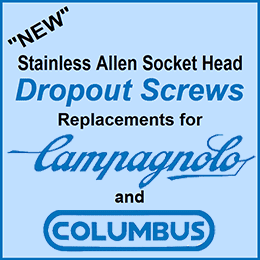Pedal Float
 Fri, May 25, 2007
Fri, May 25, 2007 A subject I often see discussed on the various bicycle forums is clipless pedals, and pedal float. This is more by way of an observation than to give advice because clipless pedals came on the market in the last few years I was in the bike business.
For many years, we all used toe clips and straps, and there was no float in the pedal cleats. Which leaves me to wonder who in their wisdom decided when designing clipless pedals, the foot needed to have sideways movement (float) on the pedal?
Was it demanded by the riders, or offered as a sales gimmick by the manufacturers as something that the “old tech” pedals didn’t have? Because like every piece of new technology that comes on the market, consumers soon find they can’t do without it.
I understand that now some pro riders are going back to fixed cleats on their clipless pedals, and the many riders who try to follow suit have all kinds of problems with their knee joints, etc.
When I started riding seriously in the early 1950s, cycling shoes had leather soles, and cleats were nailed on. They came in a little packet with 20 or 30 nails per cleat. Luckily, this was in a time before God created tennis shoes, and every household had basic shoe repair equipment.
This included a shoemaker’s last or iron foot that you put the shoe on to nail the cleats in place. Imagine doing this for the first time, staring at a flat leather sole, with absolutely no indication where the cleat should go.
You nailed them on, went out for a test ride. If they were wrong, you came home, and ripped the cleats off with a pair of pliers. Then you had to find some new nails and start over.
We soon learned where the cleats should be. If they were misaligned, guess what? We had knee problems, just like riders with clipless pedals today. It seems to me that the real problem is, not with the pedal having float, but with the correct alignment of the cleats.
I still use toe clips and straps, and my cleats are aligned as follows. With the shoes side by side, soles and heels touching, the slots in the cleats are in a straight line across both shoes. You could drop a straight edge in the slot. This means when pedaling, the inside of my foot is parallel with the crank arm. In addition, when I place the two shoes with soles facing, the slots in the cleats line up.
This means when pedaling, the inside of my foot is parallel with the crank arm. In addition, when I place the two shoes with soles facing, the slots in the cleats line up.
As usual, my post contains a little bit of history. If we look back at how we got where we are today, often the problems we encountered in the past are a clue to solving the problems of today.
 Dave Moulton | Comments Off |
Dave Moulton | Comments Off |  Bike Fit
Bike Fit 
















Reader Comments (6)
John B
Dave
I always felt plenty secure in straps, and I don’t recall any accident where the shoe stayed in and a foot was torn off.
A holistic therapist once told me the strap across my feet must break up “crystals” in my body; maybe there’s some benefit also.
I know Sean Kelly was one of the last pros to switch to clipless, and I can see why many track riders still use straps (with clipless cleats) and also why some pro roadies are adapting them.
It’s like round section handlebars and the Concor saddle: some things have been around for many years, but there’s a reason. They feel right, and work. Isn’t that enough?
It’s kind of difficult to make a more perfect circle.
There is this idea that float helps with knee problems but I think this is not true. I took up cycling after my knees could no longer take the pounding from running. Going from Look Keos with lots of float to Time Iclics with float restricted by spring re-centering force and finally Aerolites with no float, each step required more accurate cleat alignment but also more comfort and power once the correct cleat position was found.